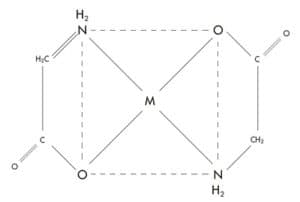Molecules play important role in plant nutrition
Making sure that sufficient quantities of essential nutrients are available in the soil is only one component of a plant nutrition program. The nutrients must also be in a form chemically available to the plant. The soil pH, composition, and the presence of other elements can affect the availability of nutrients as well.
 A type of organic molecule called a chelate may help to make nutrients available that, due to soil conditions, could not otherwise be taken up by the plant. The chelator molecule envelops the ion (magnesium calcium, iron, zinc and others), binding to it and preventing interaction with other ions in the soil. The word chelate, derived from chele, the Latin word for claw, refers to this binding action.
A type of organic molecule called a chelate may help to make nutrients available that, due to soil conditions, could not otherwise be taken up by the plant. The chelator molecule envelops the ion (magnesium calcium, iron, zinc and others), binding to it and preventing interaction with other ions in the soil. The word chelate, derived from chele, the Latin word for claw, refers to this binding action.
Chelated nutrients therefore, resist combining with other elements, which could result in the nutrients becoming “tied up,” or unavailable to the plant. Thus, chelated nutrients usually remain available to plants longer than they would in their ionic state.
For example, most forms of iron (Fe) are soluble and available to plants at a low pH (between 4.0 and 5.5). However, as the pH rises above 7.0, iron becomes insoluble and hence, unaccessible to plants. Chelated forms of iron, e.g., FeEDDHA (ethylenediamine-N,N’-bis(2-hydroxyphenylacetic acid), are still chemically available for plant uptake at a higher pH. Two other chelated forms of iron are Fe-DTPA (diethylenetriaminepentaacetic acid) and Fe-EDTA (ethylenediaminetetraacetic acid). They vary in their ability to supply iron at high soil pH; EDDHA is most effective, followed by DTPA and then EDTA.
Chelated nutrients are considered to be more efficient than nutrients that are found in metal salts with respect to plant uptake and probably even to plant metabolism. Good chelators bind essential metal ions, increasing their solubility and uptake in plants. The chelating agent cannot bind the mineral too tightly, because it becomes unavailable. Chelating agents used in agricultural nutritional programs do not bind essential metals so tightly that they cannot be released to the plant, but are strong enough to keep the nutrients from interacting with other soil compounds.
Glyphosates (such as that used in the popular herbicide Roundup), strongly chelate essential metal ions in plants that are required for proper function of metabolic pathways. Because the essential ions are bound and not usable to the plant, the metabolic pathways break down and the plant dies of malnutrition.
Synthetic chelators such as the aforementioned EDDHA, DTPA, and EDTA are widely used in agriculture, but, like glyphosates, can build up and persist in soil. Depending on the plants, concentration of residual chelates and other soil factors, this may cause problems with future nutrient uptake by crops.
Generally, KeyPlex products use natural products such as glucoheptonates and citric and humic acids as the chelating agents. These are effective chelators for magnesium, zinc, iron, calcium and other micronutrients, and they do not pose long-term problems to soil or plants because they are biodegradable. A plus for glucoheptonate is that the chelate is used as part of the plant metabolic pathway. This means the plant does not have to use extra energy to get rid of it, and it is not toxic.
